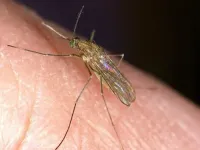(Press-News.org) Centuries-old smoke particles preserved in the ice reveal a fiery past in the Southern Hemisphere and shed new light on the future impacts of global climate change, according to new research published in Science Advances.
"Up till now, the magnitude of past fire activity, and thus the amount of smoke in the preindustrial atmosphere, has not been well characterized," said Pengfei Liu, a former graduate student and postdoctoral fellow at the Harvard John A. Paulson School of Engineering and Applied Sciences (SEAS) and first author of the paper. "These results have importance for understanding the evolution of climate change from the 1750s until today, and for predicting future climate."
One of the biggest uncertainties when it comes to predicting the future impacts of climate change is how fast surface temperatures will rise in response to increases in greenhouse gases. Predicting these temperatures is complicated since it involves the calculation of competing warming and cooling effects in the atmosphere. Greenhouse gases trap heat and warm the planet's surface while aerosol particles in the atmosphere from volcanoes, fires and other combustion cool the planet by blocking sunlight or seeding cloud cover. Understanding how sensitive surface temperature is to each of these effects and how they interact is critical to predicting the future impact of climate change.
Many of today's climate models rely on past levels of greenhouse gasses and aerosols to validate their predictions for the future. But there's a problem: While pre-industrial levels of greenhouse gasses are well documented, the amount of smoke aerosols in the preindustrial atmosphere is not.
To model smoke in the pre-industrial Southern Hemisphere, the research team looked to Antarctica, where the ice trapped smoke particles emitted from fires in Australia, Africa and South America. Ice core scientists and co-authors of the study, Joseph McConnell and Nathan Chellman from the Desert Research Institute in Nevada, measured soot, a key component of smoke, deposited in an array of 14 ice cores from across the continent, many provided by international collaborators.
"Soot deposited in glacier ice directly reflects past atmospheric concentrations so well-dated ice cores provide the most reliable long-term records," said McConnell.
What they found was unexpected.
"While most studies have assumed less fire took place in the preindustrial era, the ice cores suggested a much fierier past, at least in the Southern Hemisphere," said Loretta Mickley, Senior Research Fellow in Chemistry-Climate Interactions at SEAS and senior author of the paper.
To account for these levels of smoke, the researchers ran computer simulations that account for both wildfires and the burning practices of indigenous people.
"The computer simulations of fire show that the atmosphere of the Southern Hemisphere could have been very smoky in the century before the Industrial Revolution. Soot concentrations in the atmosphere were up to four times greater than previous studies suggested. Most of this was caused by widespread and regular burning practiced by indigenous peoples in the pre-colonial period," said Jed Kaplan, Associate Professor at the University of Hong Kong and co-author of the study.
This result agrees with the ice core records that also show that soot was abundant before the start of the industrial era and has remained relatively constant through the 20th century. The modelling suggests that as land use changes decreased fire activity, emissions from industry increased.
What does this finding mean for future surface temperatures?
By underestimating the cooling effect of smoke particles in the pre-industrial world, climate models might have over-estimated the warming effect of carbon dioxide and other greenhouse gasses in order to account for the observed increases in surface temperatures.
"Climate scientists have known that the most recent generation of climate models have been over-estimating surface temperature sensitivity to greenhouse gasses, but we haven't known why or by how much," said Liu. "This research offers a possible explanation."
"Clearly the world is warming but the key question is how fast will it warm as greenhouse gas emissions continue to rise. This research allows us to refine our predictions moving forward," said Mickley.
INFORMATION:
The research was co-authored by Yang Li, Monica Arienzo, John Kodros, Jeffrey Pierce, Michael Sigl, Johannes Freitag, Robert Mulvaney and Mark Curran.
It was funded by the National Science Foundation's Geosciences Directorate under grants AGS-1702814 and 1702830, with additional support from 0538416, 0538427, and 0839093.
Since the onset of the CRISPR genetic editing revolution, scientists have been working to leverage the technology in the development of gene drives that target pathogen-spreading mosquitoes such as Anopheles and Aedes species, which spread malaria, dengue and other life-threatening diseases.
Much less genetic engineering has been devoted to Culex genus mosquitoes, which spread devastating afflictions stemming from West Nile virus--the leading cause of mosquito-borne disease in the continental United States--as well as other viruses such as the Japanese encephalitis virus (JEV) and the pathogen causing avian malaria, a threat to ...
DALLAS - May 28, 2021 - A study of gene activity in the brain's hippocampus, led by UT Southwestern researchers, has identified marked differences between the region's anterior and posterior portions. The END ...
East Hanover, NJ. May 28, 2021. A team of researchers has shown that physical intervention plans that included exoskeleton-assisted walking helped people with spinal cord injury evacuate more efficiently and improved the consistency of their stool. This finding was reported in Journal of Clinical Medicine on March 2, 2021, in the article "The Effect of Exoskeletal-Assisted Walking on Spinal Cord Injury Bowel Function: Results from a Randomized Trial and Comparison to Other Physical Interventions" (doi: 10.3390/jcm10050964).
The authors are Peter H. Gorman, MD, of the University of Maryland School of Medicine, Gail F. Forrest, PhD, of Kessler Foundation's Tim and Caroline Reynolds Center for Spinal Stimulation, Dr. William Scott, of VA Maryland Healthcare System, ...
Neurological disorders such as Parkinson's disease and epilepsy have had some treatment success with deep brain stimulation, but those require surgical device implantation. A multidisciplinary team at Washington University in St. Louis has developed a new brain stimulation technique using focused ultrasound that is able to turn specific types of neurons in the brain on and off and precisely control motor activity without surgical device implantation.
The team, led by Hong Chen, assistant professor of biomedical engineering in the McKelvey School of Engineering and of radiation oncology at the School of Medicine, is the first to provide direct evidence showing noninvasive, cell-type-specific ...
Corals are in trouble. All across the globe the diverse and dynamic ecosystems are taking huge hits year after year. The Great Barrier Reef has lost half of its coral since 1995. Scientists are seeing similar declines in reefs from Hawai'i to the Florida Keys and across the Indo-Pacific region.
The widespread decline is fueled in part by climate-driven heatwaves that induce coral bleaching -- the breakdown of the relationship between shallow-water coral and the symbiotic algae they rely upon for nutrients.
Climate change is a clear and present danger to the persistence of coral reefs, and global reductions in carbon emissions is ...
East Hanover, NJ. May 28, 2021. A team of multiple sclerosis (MS) experts at Kessler Foundation led the first pilot randomized controlled trial of robotic-exoskeleton assisted exercise rehabilitation (REAER) effects on mobility, cognition, and brain connectivity in people with substantial MS-related disability. Their results showed that REAER is likely an effective intervention, and is a promising therapy for improving the lives of those with MS.
The article, "A pilot randomized controlled trial of robotic exoskeleton-assisted exercise rehabilitation in multiple sclerosis," (doi: 10.1016/j.msard.2021.102936) was published on April 4, 2021, by Multiple Sclerosis and Related Disorders. It is available open access at https://www.msard-journal.com/article/S2211-0348(21)00203-0/fulltext.
The ...
Adults with cerebral palsy are more likely to experience the debilitating pains of musculoskeletal disorders, but they receive significantly less physical therapy for those ailments, according to a recent study.
The findings, published in Disability & Health, analyzed four years of Medicare service claims from community-living older adults with and without cerebral palsy who had one or more ambulatory claims for a musculoskeletal diagnosis. Fewer than one-third of general population patients utilized physical therapy. Those with cerebral palsy, despite having greater risk of secondary comorbid conditions, received even less physical therapy.
"The results are staggering, but they support our hypothesis that people with cerebral palsy receive inequitable health care," says Mark ...
Climate change will make outbreaks of West Nile virus more likely in the UK within the next 20-30 years, scientists say.
West Nile virus is spread by mosquitoes and has no vaccine. Most people have no symptoms, but it can cause serious neurological disease.
Scientists from the UK Centre for Ecology & Hydrology (UKCEH), Biomathematics and Statistics Scotland (BioSS) and the University of Glasgow developed a new model to determine the risk of a West Nile virus outbreak in the UK.
They found the risk is low for the next two to three decades, but will increase as temperatures ...
The drug diABZI -- which activates the body's innate immune response -- was highly effective in preventing severe COVID-19 in mice that were infected with SARS-CoV-2, according to scientists in the Perelman School of Medicine at the University of Pennsylvania. The findings, published this month in Science Immunology, suggest that diABZI could also treat other respiratory coronaviruses.
"Few drugs have been identified as game-changers in blocking SARS-CoV-2 infection. This paper is the first to show that activating an early immune response therapeutically with a single dose is a promising strategy for controlling the virus, including the South African variant ...
What The Study Did: Rates of antispike antibody response to a messenger RNA SARS-CoV-2 vaccine in Israeli patients with cancer who are undergoing systemic treatment compared with healthy controls were evaluated in this study.
Authors: Salomon M. Stemmer, M.D., of the Rabin Medical Center in Petah Tikva, Israel, is the corresponding author.
To access the embargoed study: Visit our For The Media website at this link https://media.jamanetwork.com/
(doi:10.1001/jamaoncol.2021.2155)
Editor's Note: The article includes conflict of interest disclosures. Please see the article for additional information, ...



